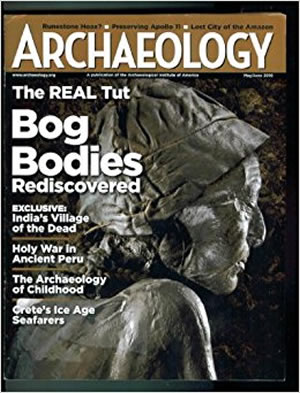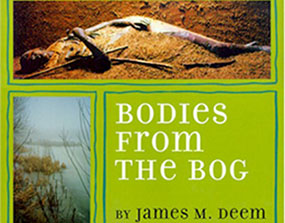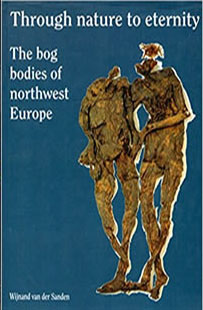Paperback edition, 2003.
|
~~ Suggestions for Visiting Bogs and Bog Bodies ~~ ~~ Bog Body Stories ~~ Related Books by James M Deem: Bodies from the Ice ~~ Bodies from the Ash ~~ ~~ |
Tollund Man
A Sacrifice to the Gods
On the afternoon of May 6, 1950, two brothers were working in the Bjaeldskov bog, an area about 6 miles west of the Danish town of Silkeborg. They had already planted their spring crops on their nearby farms and were taking time that afternoon to cut some peat to use for heating their houses and cooking their meals.
As their bog shovels sliced through the peat, they struck something hard. After more digging, they came upon the lifeless body of a man. He was quite dead, but his face appeared so fresh that they immediately thought he had been murdered recently and dumped in the bog. They contacted the police, and soon officers arrived at the site. But the police knew the history of the bog. They remembered that two other bodies had been found in the same bog, once in 1927 and again in 1938. Rather than start a murder investigation, they called an archaeologist at a nearby university and invited him to see the body of the man who would soon be named Tollund Man, after the village in which the brothers lived.
Late that same afternoon, archaeologist P. V. Glob got a good look at the well-preserved man in the fading light of the day. By now, the man had been uncovered from his resting place eight feet deep in the bog. Glob realized that the man had been in the bog a long time. He noted that the man’s skin was coffee brown, and his short hair was red, both colored by their contact with the water of the bog.  He wore only a cap on his head (made from eight pieces of sheepskin, the wool inside) and a leather belt around his waist. Otherwise, he was naked, although any fabric clothing he wore would have dissolved over time in the bog. He looked as if he were sleeping, laying on his side.
He wore only a cap on his head (made from eight pieces of sheepskin, the wool inside) and a leather belt around his waist. Otherwise, he was naked, although any fabric clothing he wore would have dissolved over time in the bog. He looked as if he were sleeping, laying on his side.
When a small piece of peat was removed from his neck, however, the professor saw something else: a two-strand leather rope tied in a noose was tightly closed around his neck. Tollund Man, Glob realized, had been killed and buried in a grave that had been cut from the peat.
To study the body further, Glob would have to move Tollund Man to a museum. He had workers build a wooden box around the dead man so that he could be transported exactly as he had been discovered to Copenhagen’s National Museum. After a week long train ride through Denmark, Tollund Man arrived at the museum where he was eagerly examined. They quickly concluded, by analyzing the age of the peat that surrounded him, that Tollund Man had been killed some 2,000 years earlier, during the early Iron Age. Later, results from Carbon-14 dating indicated that he had died about the year 350 BC.
They examined every inch of his body, noting that his head and feet were much better preserved than the rest of his body. His legs and arms, for example, had mostly turned to skeleton; the soft tissues there had deteriorated. By studying his bones, they determined that he was about 40 years old when he died. He stood slightly over five feet tall. He walked barefoot sometimes, they decided, for there were scars on the bottom of one foot.
Scientists were particularly interested in his stomach and intestines, for they wanted to know what he had eaten before he died. They washed these organs, then removed their contents for analysis. Inside the stomach they found very little, but the large intestine contained the remains of gruel, a coarse vegetable soup made in this case from some barley, 30 types of seed, and many weeds. The fact that the meal had entered the large intestine told scientists that Tollund Man had eaten his last meal at least some 12-24 hours before he died. Later, when two archaeologists tried to use the list of ingredients and cook the same gruel in 1954, they were unpleasantly surprised by the terrible taste.
By the end of their examination, scientists were fairly certain that Tollund Man had been sacrificed to the gods for a number of reasons. First, he was buried in the type of watery place where the early people of Europe believed they could communicate with their many gods and goddesses. Second, the contents of his intestines appeared to indicate that he was killed in the winter or early spring, a time that human sacrifices were made to the goddess of spring. Finally, his body was well treated after he was hung, something that wouldn't have happened if he were a common criminal. He was picked up and carefully placed in his grave. The people who buried him, scientists believe, also closed his eyes and mouth after he died.
Following the lengthy examination, Tollund Man’s body was in pieces and in danger of decay. Preserved in an anaerobic (that is, oxygen-free) environment for 2,000 years, he had once again been introduced to a bacteria-filled atmosphere. His body had already begun to deteriorate. Scientists decided to preserve only his head and one foot. The rest of him had become dehydrated and was sent away for further study. After a year of preservation baths, the head and foot were sent to the Silkeborg Museum where they were placed on display. In 1987, the dehydrated parts of Tollund Man were returned, restored, and reassembled once again, so that a cast could be made of the body.

This account originally appeared as "Tollund Man" (by James M. Deem) in Dig magazine (September 2005).





